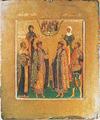- Stroganov school
-
School of icon painting named for its original patrons, the Stroganov family, that flourished in Russia in the late 16th and 17th century.The artists perfected their work in the service of the tsar in Moscow. The paintings, designed for private use, were produced in a muted colour range dominated by golden browns with gold and silver linear highlights. Small and exquisitely detailed and embellished with frames and halos of beaten gold and silver, they represent the last vital stage of Russian medieval painting before the westernization of Russian art at the end of the 17th century.
 "SS. Boris and Gleb," icon by a follower of Prokopy Chirin, Stroganov school, 17th ...Novosti Press Agency, Moscow
"SS. Boris and Gleb," icon by a follower of Prokopy Chirin, Stroganov school, 17th ...Novosti Press Agency, Moscow* * *
▪ Christian artschool of icon painting that flourished in Russia in the late 16th and 17th centuries. The original patrons of this group of artists were the wealthy Stroganov family, colonizers in northeastern Russia; but the artists perfected their work in the service of the tsar and his family in Moscow. Representing the last vital stage of Russian medieval painting before the westernization of Russian art at the end of the 17th century, the so-called Stroganov school produced not so much a coherent style as a type of icon. Designed specifically for private use, this type was characterized by its small size, its miniature technique, and its exquisite refinement of detail. The icons of the Stroganov school, while retaining Byzantine-inspired Russian forms, nevertheless represent a radical departure from most of what had been valued in the long tradition of Russian painting; monumentality was replaced by precious virtuosity and deep emotion by decorative elegance. The preoccupation with style and technique over content was, perhaps, typical of the end of a cultural phase.In its richness and refinement, the art of the Stroganov school reflected the tastes of royal and noble patrons. Working in a muted colour range dominated by golden brown, the Stroganov masters substituted for the colouristic brilliance of the earlier Russian tradition a lavish use of gold and silver linear highlights whose strongly abstract patterns matched the mannered fragility of the figures. They embellished their icons with frames and halos of beaten gold and silver. The naturalism proscribed by the church for major representations was ingeniously introduced by the Stroganov school in background details of architecture, vegetation, and even atmospheric effects. Finally, the Stroganov masters excelled at composition; though their works are very small and sometimes include many figures, they never appear crowded.The Stroganov school remained influential until the end of the 17th century, but after about 1650 it gradually declined and lost its refinement. The foundation of the new capital of St. Petersburg in 1703 by Tsar Peter I the Great marked a turning point in Russian art: although icon painting continued to follow the Russo-Byzantine tradition throughout the 19th century, the major artistic activity shifted to secular art and Europe's Baroque style.* * *
Universalium. 2010.
